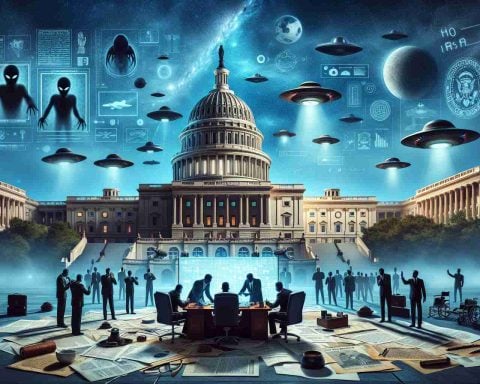- Catamarans in Ushuaia led tourists to capture a mysterious metallic anomaly in the Beagle Channel, sparking global speculation.
- The image features a reflective object sparking debates on whether it’s a light trick, camera quirk, or something exotic.
- Ushuaia has a history of UFO sightings, enhancing its reputation as a hub for unexplained phenomena.
- Official responses to the sighting remain absent, intensifying public curiosity and discussions.
- In Buenos Aires, a “UFO” sighting of white streaks in the night was identified as Starlink satellites.
- The events underscore humanity’s fascination with mysteries and the quest for understanding the unknown.
As catamarans glided serenely through the icy waters of the Beagle Channel, bathed in the crisp sunlight of Ushuaia, an unexpected enigma unfolded above. An innocent excursion to glimpse a colony of penguins turned into a whirlwind of intrigue when tourists captured an image that would ignite speculation worldwide.
Among the myriad snapshots from that chilly day, one photograph soared, metaphorically, far above the rest. On first inspection, nothing seemed unusual. But later, as eager eyes scanned through the captured memories, a metallic anomaly hovered mysteriously above the rippling sea.
This object, gleaming like a polished mirror, reflecting the sun’s forgiving embrace, sparked fervent debates: Was this a mere trick of light, a quirk of modern camera technology, or did it herald something far more exotic? The digital jury is still out, but the extraterrestrial echoes are hard to ignore.
Ushuaia, perched at the edge of the Earth, is no stranger to such celestial enigmas. For years, stories of unidentified flying objects have drifted through this remote corner of the world, cementing its status as a potential hotspot for the unexplainable. Yet, as the conversations intensify, official voices remain resolutely silent, leaving a vacuum where only questions echo.
Meanwhile, in the bustling heart of Buenos Aires, the sky offered another surprise. A stark white line, cutting through the night, sent imaginations racing. Theories ranged from meteorites on a fiery journey to more UFO musings. However, the reality was tethered to Earth—orbiting it, rather—in the shape of Starlink satellites, twinkling like a cosmic train.
Amidst this celestial theater, what remains crucial is our boundless curiosity and the enduring allure of mysteries that defy easy answers. In our search for the unknown, perhaps we discover more about ourselves than the universe ever planned to reveal.
Unveiling Ushuaia’s Mysteries: Is It a UFO or Mere Illusion?
How-To Steps & Life Hacks for Capturing UFO Phenomena
1. Right Equipment: Use a DSLR camera with a zoom lens for clarity. A tripod ensures steady shots, reducing blurriness.
2. Optimal Settings: Set the camera at a high shutter speed and aperture of around f/8. Adjust ISO based on lighting.
3. Timing Matters: Capture images during dawn or dusk when lighting can produce dramatic effects but isn’t too harsh.
4. Enhance with Tech: Use apps like NightCap for mobile or post-edit with software such as Adobe Lightroom to adjust contrast and highlight potential anomalies.
Real-World Use Cases
The increase in UFO sightings, such as in Ushuaia, highlights opportunities for scientific studies into atmospheric phenomena. This area offers fertile ground for researchers of meteorology, aviation, and astronomy.
Market Forecasts & Industry Trends
Interest in UFOs and extraterrestrial phenomena is set to rise. According to a report by MarketWatch, the global exploration market is projected to grow significantly, driven by a combination of media interest and an increasing number of scientific expeditions.
Reviews & Comparisons
Comparing photographic evidence, experts often cite atmospheric reflections and satellite glints as more probable explanations than alien technology. National Geographic has insightful comparisons illustrating how ordinary objects are often mistaken for UFOs.
Controversies & Limitations
The main controversy revolves around whether UFO sightings truly indicate extraterrestrial life or are merely misinterpretations of explainable phenomena. The scientific community often argues for the latter, suggesting that human perception and technology limitations fuel belief in UFOs.
Features, Specs & Pricing
Regarding cameras used for capturing UFOs, models like the Canon EOS R5 or Sony A7III are popular. Prices vary from $2,500 to $3,500, offering high-resolution capabilities essential for night photography.
Security & Sustainability
Camera drones, useful for aerial photography of UFOs, raise issues around airspace regulation and wildlife disturbance. It’s imperative to comply with local aviation rules to ensure ethical and safe exploration.
Insights & Predictions
With the release of more governmental UFO reports, public interest in UFOs could spark a tourism uptick in potential hotspot locations like Ushuaia, opening economic doors. Furthermore, scientific consensus may bridge the gap between skepticism and belief.
Tutorials & Compatibility
For beginners, numerous YouTube channels offer tutorials on capturing celestial phenomena. Ensure your camera software is updated to maintain compatibility with editing programs.
Pros & Cons Overview
Pros:
– Engages public interest in space and science.
– Encourages technological advancement in imaging.
– Boosts local tourism and economies.
Cons:
– Fuels conspiracy theories.
– Potential breaches in airspace privacy.
– Misinterpretations can lead to misinformation.
Actionable Recommendations
1. Visit Verified UFO Spots: Plan trips to known sites like Roswell or Area 51 for a unique tourist experience.
2. Equip Yourself: Invest in a good camera and learn its features.
3. Educate Yourself: Separate myths from reality by reading scientific publications on atmospheric anomalies.
4. Engage with Communities: Join forums and groups who share your interest for updates and insights.
For more comprehensive exploration of UFO phenomena, check National Geographic. Discover more mysteries, and perhaps uncover truths that challenge your skepticism.



















